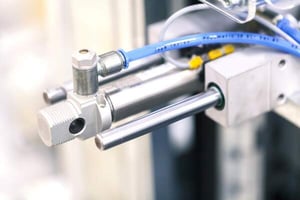 Department of Transportation (D.O.T.)-approved push-to-connect fittings are the most used connection in air brake applications on large vehicles, such as trucks, trailers and trains. Push-to-connect fitting are well-suited for installation in confined areas. However, D.O.T. regulations require all nylon tubing air brake connections to have an inner tube support in their fittings. Inner tube support is an internal metal tube placed inside an already existing tube, to provide solid connections for over-the-road air brake systems.
Department of Transportation (D.O.T.)-approved push-to-connect fittings are the most used connection in air brake applications on large vehicles, such as trucks, trailers and trains. Push-to-connect fitting are well-suited for installation in confined areas. However, D.O.T. regulations require all nylon tubing air brake connections to have an inner tube support in their fittings. Inner tube support is an internal metal tube placed inside an already existing tube, to provide solid connections for over-the-road air brake systems.
Push-to-connect versus compression fittings
Push-to-connect fittings
Push-to-connect fittings are a type of fitting that allows an air line to be attached without using tools. This feature allows components to save time while reducing the possibility of damage caused to the equipment. Unlike compression fittings, push-to-connects are excellent for preventing leaks, as they do not need to be tightened to remain leak-free. Crimping can occur when the compression fittings are too tight, resulting in an increased chance of future leaks. Additionally, push-to-connect fittings have the advantage of not containing the compression nut and ferrule found in compression fittings which can bite into the tube, increasing the chance of leakage.
While push-to-connect fittings usually cost more, they provide faster installation and lower maintenance costs that make up for the higher purchasing price. Overall, push-to-connect fittings are an excellent and easy option for projects and applications.
Compression fittings
Compression fittings are also D.O.T. approved for many air brake applications and usually cost less than push-to-connect fittings. However, compression fittings are not the quickest or easiest to install, connect or reconnect onto applications. They connect tubing to threaded components or other sections of tubing and consist of a body, a one-piece ferrule and a compression nut.
Compression fittings require tools for installation, which can be time-consuming and more complex in tighter spaces. While compression fittings require a nut on specific torque ratings, push-to-connect fittings do not consist of a compression nut. Instead, push-to-connect fittings have a leak-free seal that is quickly achieved by pushing the fitting onto the tube or hose.
In compression fittings, a seal is achieved through threads that screw onto the connection. Compression fittings are available in more sizes and configurations than push-to-connect fittings, allowing for a broader range of options. They can withstand higher-pressures, however, they are heavier than push-to-connects and sometimes require more bracketing to secure the lines, adding more weight to the vehicle. Though minor for one vehicle, the extra weight can increase fuel consumption considerably for a fleet.
Important requirements and specifications
Properly designed compression and push-to-connect fittings meet or exceed D.O.T. requirements, but to ensure a proper fitting selection for a specific application, it is essential to confirm the following:
- Required pounds per square inch (PSI) pressure rating
- Certain thread type (if applicable)
- Type and material of tube or hose
When dealing with maintenance applications, refer to the vehilce’s service manual for the specific application. Additionally, the primary specifications of air brake push-to-connect fittings for tractor-trailer air brake systems include:
- Brass fitting thread connections with stainless steel tube support (some styles)
- Compatible with SAE J844 Type A & B nylon tubing
- Male pipe, female pipe and SAE straight thread (some styles)
- Specified up to 250 PSI
- SAE J2494 and D.O.T. requirements
- FMVSS 571.106 air brake specifications for available sizes of 1/4" to 1/2"
- Stainless steel tube support for maximum flow for SAE J3494-3
If you'd like to learn more about PTC standards, applications & specs, click here or below to download our latest whitepaper that includes comprehensive information about PTC Fittings!

